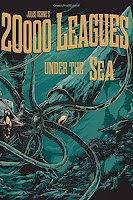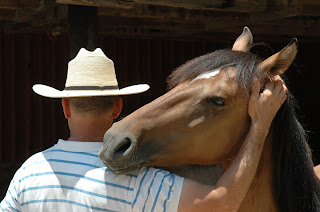Book Challenge, Days 5, 6, and 7: Submarines, Aliens, and Horses
Day 5 -- 20,000 Leagues Under the Sea -- Jules Verne 1870
Book 5/10 is Jules Verne's 20,000 Leagues Under the Sea. (N.B. A league is about 3.452 miles.) I'm not sure how I got this paperback, but I re-read it so many times, I eventually had to tape the binding, then cover the paper cover with grocery sack paper (reinforced with cardboard), and then the pages started falling out. When I first read it (in about 3rd grade), I thought the 20,000 leagues referred to depth, not distance traveled. Imagine my confusion. I also remember feeling as if I couldn't breathe when they were trapped below. I used to really lose myself in a book. This opened up the science fiction genre for me, and I've been a fan ever since. I'm also partial to a good sea-faring yarn - Melville's Moby Dick & Billy Budd, Dana's Two Years Before the Mast, Philbrick's In the Heart of the Sea, Junger's The Perfect Storm, and Greenlaw's (the woman captain from The Perfect Storm) The Hungry Ocean (among others). Maybe it's why an Iowa landlubber joined the Navy.After reading the book, I happened upon the 1954 Disney movie of the same name, starring Kirk Douglas, Peter Lorre, Paul Lucas, and James Mason as the charismatic anti-hero, Nemo. I may have seen it on television or at the Saturday matinee. But I loved it, especially the battle with the giant squid. It is interesting to note that Nemo takes the "guests" to the penal colony on Rorapandi (pronounced Rura Penthe), where he had been held captive. There they ram a ship being loaded with munitions by the prisoners. Now, does that penal colony name ring any bells? If you're a Trekkie, it might. It's the penal colony Kirk and McCoy are sent to (here called Rora Penthe) by the Klingons in Star Trek VI: The Undiscovered Country.
Day 6 -- The Greks Bring Gifts -- Murray Leinster 1964
This has been quite entertaining (at least for me) and enlightening. I have never given much thought to the books that I read as a child and how they influenced or impressed me. After day 1, I haven’t challenged any individuals, but if you have the time and the curiosity, you ought to try it. Hack it out in a journal to see if you can produce 10 books. Today’s book challenges the “childhood” definition a bit (maybe). This book was published when I was 13, and I probably read it a year or two later. By this time, I was in paperback book club. Heaven knows how I paid for it, but I finally had enough books to read, and they were all mine! Bwa ha ha! So, we see the beginnings of my bibliophilia. This book is Murray Leinster’s The Greks Bring Gifts. The blurb for this 1964 classic sci fi novel is “The Greks promised a world in which everyone would be rich – provided the Greks were allowed to rule. It was a bargain few Earthmen could resist.” It hearkens to the post-Trojan horse adage, “Beware of Greeks bearing gifts.” The dialogue, and maybe even the plot, seem a bit cheesy these days, with all our “hard” science fiction and space operas, but remember, in 1964, we hadn’t even been to the moon yet. John Glen flew around the Earth three times two years before. I haven’t read this book since the 60s, but it made a definite impression on me then. Mostly, it was “don’t be stupid.” But it also may have reaffirmed the business about Greeks and gifts (apologies to my friends of Grecian heritage) – you know, the old “too good to be true” business. The first part of the book seems a bit comic as the Greks bestow gifts on Earth with apparently no strings attached. They give us all this cool stuff, and then they leave. But when everything stops working, Earthers beg the Greks to come back and fix it. And the Greks agree, but on their terms. Ay, there’s the rub.
Day 7 -- Justin Morgan Had a Horse -- Marguerite Henry 1945

I want to revisit Marguerite Henry for book 7/10. As I may have said when posting about Brighty of the Grand Canyon, after reading that book, Marguerite Henry became on of my favorite authors, and I read nearly everything she wrote, especially if it was illustrated by Wesley Dennis. Another favorite was Walter Farley’s The Black Stallion (and all 20 books in that series) because I was having the pre-teen girl obsession with horses. So, when I found Justin Morgan Had a Horse, I checked it out from the library. Little Bub (real name – Figure) is a runt as a colt, but when he grows up, he can pull bigger loads than a pair of oxen and he’s faster than thoroughbreds. This “based on a true story” novel traces the beginnings of the Morgan breed of domestic horse. Nobody really knows what Figure’s bloodline was, but it is generally accepted that he was part Arabian, thoroughbred, and maybe Welsh cob or Friesian.
The Morgan is an exceptionally talented breed, used for all types of riding and driving and can also be a stock horse. They are sometimes born with a “fifth gait.” All horses, as they gain move and gain speed, go through a walk, canter, trot, and gallop. But a Morgan has a gait between a walk and a canter, called a “rack.” It is a smooth gait and easy on a rider. As you see, this book had a big impression on me, and I always wanted to own a Morgan horse (just like I wanted to raise Irish setters after I read Jim Kjelgaaard’s Big Red).
In 2017, we were making stops during the Bosque Countywide Garage Sale, and a couple outside of Valley Mills had a 14-month old Morgan cross (we’re not sure what she’s crossed with) named Savannah – from Iowa, no less. She was sweet and gentle and could already rack. I figured this was as close as I was ever going to get to owning a Morgan horse, so I bought her. Turns out, she’s a diva and hates training, but I still love her.







Comments